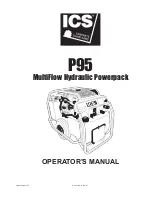
39
Further explana-
tions of the “Eln”
characteristic-
selection func-
tion
(continued)
The anti-stick function can be activated and deactivated in the “Set-up menu: Level 2”
(see the section headed: “Set-up menu: Level 2”).
As the arc becomes shorter, the welding voltage may drop so far that the rod electrode
will tend to “stick”. This may also cause “burn-out” of the rod electrode.
Electrode burn-out is prevented if the anti-stick function has been activated. If the rod
electrode begins to stick, the power source immediately switches the welding current off.
After the rod electrode has been detached from the workpiece, the welding operation
can be continued without difficulty.
Depending on what welding current (I) has been set, the point of intersection (operating
point) of characteristics , and will be displaced along the load line . The opera-
ting point provides information on the actual welding voltage and the actual welding
current.
Where the welding current (I
1
) is permanently set, the operating point may migrate along
the characteristics , and , depending on the welding voltage at that moment in
time. The welding voltage U is dependent upon the length of the arc.
If the arc length changes, e.g. in accordance with the load line , the resulting operating
point will be the point where the corresponding characteristic , or intersects with
the load line .
Applies to characteristics and : Depending upon the welding voltage (arc length), the
welding current (I) will also become either smaller or larger, even though the value set
for I
1
remains the same.
Anti-stick func-
tion
Summary of Contents for CastoTIG
Page 2: ......
Page 4: ......
Page 16: ...ud_ca_st_sv_00676 032003 XII ...
Page 76: ...CastoTIG 2201 DC ...
Page 77: ...CastoTIG 1702 AC DC ...
Page 78: ...CastoTIG 2202 AC DC ...
















































